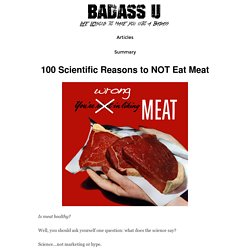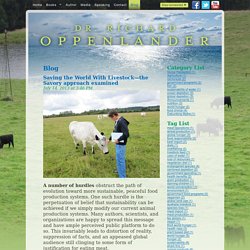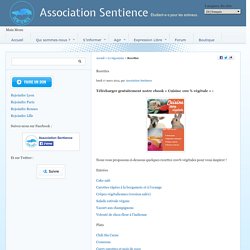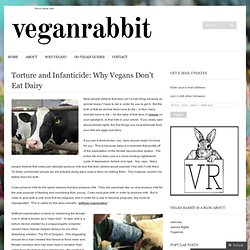

Quand l'amour est (vraiment) dans le pré Les temps sont agités pour le monde de l'élevage: reconnaissance des animaux comme êtres "doués de sensibilité" dans le code civil, plaidoyers à charge d'auteurs et de journalistes, manifestations d'éleveurs, contre-communication permanente des filières de productions animales...: la question de la place des animaux dans nos sociétés se pose avec une acuité grandissante.

Si les syndicats agricoles tendent à pousser des représentants de l'élevage en plein-air devant les caméras pour illustrer l'importance accordée par la profession au bien-être des animaux, cette stratégie de communication s'effondre devant l'évocation de la simple réalité chiffrée. Elle confirme que l'élevage français est, au contraire, un élevage majoritairement hors-sol et intensif: 82% des poulets grandissent à un rythme accéléré dans des bâtiments clos, 70% des poules pondeuses vivent en cage, 95% des cochons vivent entassés sur un sol bétonné, 99% des lapins vivent en cage de batterie. Distinguer la vraie fourrure de la fausse.
100 Scientific Reasons to NOT Eat Meat. Is meat healthy?

Well, you should ask yourself one question: what does the science say? Science…not marketing or hype. For example, do you believe that a pomegranate has more and/or superior antioxidants than, say, an apple? If you said yes, then you are a victim of hype. And this hype was from twisting the truth of a scientific study… As mentioned in Wikipedia: Despite limited research data, manufacturers and marketers of pomegranate juice have liberally used evolving research results for product promotion, especially for putative antioxidant health benefits.
Source: “Pom Wonderful Warning Letter”. Don’t buy into the hype. Saving the World With Livestock—the Savory approach examined. July 14, 2013 at 3:46 PM A number of hurdles obstruct the path of evolution toward more sustainable, peaceful food production systems.

One such hurdle is the perpetuation of belief that sustainability can be achieved if we simply modify our current animal production systems. Many authors, scientists, and organizations are happy to spread this message and have ample perceived public platform to do so. This invariably leads to distortion of reality, suppression of facts, and an appeased global audience still clinging to some form of justification for eating meat. With two annual conferences and worldwide acclaim, the TED talks have brought audiences “Ideas Worth Spreading” since 1984. Mr. Savory’s TED talk was compelling and certainly provided what all carnivores wanted to hear (hence, the standing ovation). The problem at hand is that we eat meat. Savory provided the audience with examples of restored land using his livestock and grazing techniques in Africa, Argentina, and Mexico. Home. Recettes - Association Sentience. Skip to content Association Sentience Étudiant-e-s pour les animaux.

Main Menu Accueil > Le véganisme > Recettes Recettes lundi 17 mars 2014, par Association Sentience. Torture and Infanticide: Why Vegans Don’t Eat Dairy. Most people believe that dairy isn’t a bad thing because an animal doesn’t have to die in order for you to get it.

But the truth is that an animal does have to die – in fact, many animals have to die – for the sake of that slice of cheese on your sandwich, or that milk in your cereal. If you really care about animal rights, the first things you must eliminate from your diet are eggs and dairy. If you are a feminist like I am, dairy should really hit home for you. This is because dairy is a business that profits off of the exploitation of the female reproductive system. The entire life of a dairy cow is a never-ending nightmarish cycle of depression, torture and rape.
Cows produce milk for the same reasons humans produce milk. Artificial insemination is done by restraining the female cow in what is known as a “rape rack”. This same device — this “rape rack” – is what is used today to restrain female cows for artificial insemination. Cows do not like to be milked. Un peuple asiatique aurait trouvé l'élixir de jouvence. Le peuple des Hunzas aurait-il trouvé la recette de la jeunesse éternelle ?

Dans la vallée du fleuve Hunza, à plus de 2.400 mètres d’altitude, entre l’Inde et le Pakistan, se trouve un lieu dénommé « l’oasis de jeunesse », habité par le peuple des Hunzas ou plus précisément des Hunzakuts. Parmi les supposées caractéristiques des Hunzas, une absence presque totale de maladies, une espérance de vie d’en moyenne 110 ou 120 ans et une apparence physique plus jeune. Les habitants de Hunza se distinguent de leurs voisins les plus proches vivant dans les mêmes conditions climatiques en de nombreux aspects. Dans un premier temps, ils sont physionomiquement plus grands et ressemblent davantage à des Européens. Ensuite, ils parlent leur propre langue – le bourouchaski – un isolat linguistique comparable à aucun autre idiome du monde et pratiquent un islam modéré, écrit La Vanguardia qui cite le site russe Marketium. En Angleterre, McCarrisson a mené une expérience sur un grand nombre d’animaux. Penser avant d’ouvrir la bouche.
Collectif citoyen "269 Life France", mouvement mondial 269life.